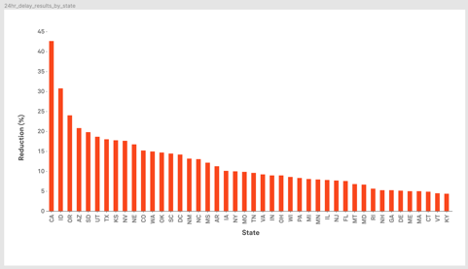
A new study from Sense and Singularity Energy demonstrates the potential for significant carbon reductions from electric vehicle (EV) charging using a combination of smart home automation and location- and time-based carbon emissions data from the power grid. The study found that by automating charging to minimize carbon impact, carbon emissions from EV charging could be reduced 8-14% on average across the U.S., with much greater reductions in California.
The potential reductions in California are more dramatic (up to 43%) because California’s grid relies on renewable energy for nearly half of its electricity, much of it from low-carbon sources such as solar and wind, which contribute to significant variations in carbon intensity, a measure of carbon emissions per unit of energy consumed and this is what accounts for the greater reduction in carbon emissions from smart charging.
As states increase their reliance on renewable energy sources, their variability will increase, too, offering similar opportunities to shift usage to times when carbon intensity is lowest.
The study examined consumers’ EV charging patterns using over 100,000 sessions of in-field EV charging data and time-based carbon intensity data for 30 major regional grid balancing authorities for utilities. It found that charging dynamically to minimize carbon utilization was consistently more effective at reducing carbon than Time of Use (TOU) rates.
The results show that smart home automation can dynamically adjust energy usage to address both grid constraints and carbon emissions goals. A separate study of 1100 California homes conducted by Sense found that 55% of electricity usage in the evening time frame could be shifted to other times during the day or reduced. Using an automated, dynamic approach, utilities can incentivize customers to reduce peak emissions by shifting their activities, including EV charging, similar to the current incentives to reduce peak demand.
Not just EV charging
Carbon reductions from automated EV charging could have a significant impact on reaching carbon emissions goals to slow climate change, and while EV charging is the most obvious case, similar opportunities for savings apply to other large loads in the home. The best opportunities for load shaping are activities that can be scheduled flexibly, like running a dishwasher or washing machine during overnight hours to have clean clothes and dishes ready when they’re needed in the morning. For these cases, automation can provide the right balance of meeting consumer needs and optimizing cost, carbon emissions, and constraints of the grid.
Carbon reductions are influenced by the regional mix of energy sources, with some regions offering a potential for higher reductions because of greater variability of carbon intensity in their fuel sources. Among the top 10 balancing authorities, CAISO (California Independent System Operator) had the highest variation in carbon intensity at 307%, followed by SWPP (Southwest Power Pool) at 259%, ERCOT Electric Reliability Council of Texas) at 197% and BPAT (Bonneville Power Authority Transmission) at 181%. For more details, see the complete study.
The analysis showed that most regions can achieve significant carbon reductions by automating EV charging to take advantage of the cleanest energy sources as they come onto the grid. As more states and regions increase the share of energy produced by renewable sources, the carbon savings potential will increase across the country.
Sense CEO Mike Phillips said that the adding intelligence to the home is a key part of a low-carbon future. “As we work on decarbonizing the grid, because of the increased use of intermittent low-carbon energy sources, it is becoming increasingly important to influence not only how much power is being used, but when it is used,” he said in a press release.
“Fortunately, there are many things in the home where people only care about the result – not when the energy is used. EV charging is a great example, but automation can extend to other key consumers of energy as we build intelligence into the infrastructure of the home,” he added.
Said Wenbo Shi, CEO and co-founder of Singularity Energy explained that data-driven carbon intelligence can improve energy management strategies and cost-effectively reduce carbon emissions.
“We are filling a gap between decarbonization targets measured in tons of carbon and existing energy management strategies that are still kWh and cost driven,” he said, adding, “There is a massive opportunity to apply the technology to EVs and other smart devices at scale to rapidly accelerate the transition towards a clean energy future.”
Implications for utilities’ demand management strategies
With EV adoption predicted to grow rapidly, propelled in part by the Biden administration’s plan to build out a national network of 500,000 EV charging stations, utilities are predicting big increases in electricity usage from EV charging over the coming decade. At the same, aggressive carbon reduction goals at the state and federal levels have mandated that utilities must reduce carbon emissions.

While meeting CO2 reduction goals and anticipating new energy loads from electric vehicles, utilities need to keep pace with more intermittent sources of power. The ability to jointly optimize for CO2, cost, and grid constraints can provide the best performance at a system level. Dynamic signals from the power grid combined with EV charging automation could be used to inform utilities’ incentive programs, influence consumer behavior, modulate peak demand as EV adoption grows, and reduce carbon.
About the Study
The study examined 100,000 sessions of in-field electric vehicle charging data and analyzed the location- and time-based fuel mix of the power grid to characterize the carbon intensity of common EV charging patterns. It drew on anonymized Sense home energy data and high-quality carbon intensity data from Singularity Energy’s Carbonara platform. Previous analyses of carbon intensity have relied on annual averages that can be two or three years old. Combining these real-time data sets, the study simulated EV charging for carbon intensity to identify carbon reductions.




